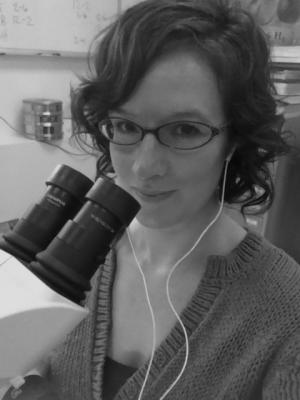
Office Location:
Specialization:
- Coastal Hunter-Gatherers, Channel Islands, Santa Cruz Island, Chumash
- Middle Holocene
- Shellfish
- Paleoethnobotany, Starch, Phytoliths
Education:
2017 Ph.D. in Anthropology, University of California, Santa Barbara
2010 M.A. in Anthropology, University of California, Santa Barbara
2006 B.A. in Anthropology, Pitzer College, Claremont, California
Research:
My research interests include California prehistory, coastal hunter-gatherers, and integrated subsistence studies. I have been fortunate enough to work on six of the eight Channel Islands and am passionate about understanding human-environmental interactions, particularly on the islands and within the Santa Barbara Channel Region. My current research is geared toward better understanding the role of interior sites and terrestrial resources during the Middle Holocene. My laboratory methods include faunal, macrobotanical, starch, and phytolith analysis. In 2010, I began building the microbotany laboratory at UCSB, under Dr. VanDerwarker's supervision. I've recently recovered both starch and phytoliths from Middle Holocene (6650-3350 cal BP) groundstone from Santa Cruz Island, and am currently in the process of excavating six Middle Holocene sites for my dissertation, “Hunter-Gatherer Subsistence and Mobility: A Case Study from Santa Cruz Island.” Funding for my field research and for microbotanical laboratory supplies has been generously provided through a Mildred E. Mathias Graduate Student Research Grant and through the Peter F. Paige Memorial Fund.
Projects:
Terrestrial Resource Use on Santa Cruz Island
Kristin Hoppa is analyzing macrobotanical samples from six Middle Holocene sites located on Santa Cruz Island. Although initial samples from SCRI-174 and SCRI-183 contained a low density of seeds, those recovered were largely from medicinal plants. The current study is looking at larger samples (>100 liters) from six Middle Holocene sites in a range of environments and elevations. Macrobotanical analysis will be combined with faunal and microbotanical analysis in order to gain a better understanding of Middle Holocene subsistence and mobility.
Funding for this project comes from a Mildred E. Mathias Graduate Student Research Grant.
Recovering Starch and Phytoliths from Middle Holocene Groundstone
 While we know a great deal about historical plant use among the Chumash (largely due to the field notes of John P. Harrington), it is problematic to assume continuity throughout the more than 12,000 years of occupation. Within the Santa Barbara Channel region, the role of plants has been largely inferred from ethnographic studies, artifact association (e.g., the presence of mortars and pestles used to infer acorn processing), and macrobotanical analyses. This project seeks direct evidence of groundstone use in the form of starch grains and phytoliths recovered from the surface of artifacts. Because many plants, such as roots or tubers, may not preserve in the macrobotanical record, starch and phytolith analysis allows for the recovery of a larger suite of resources. Kristin Hoppa is currently testing groundstone from Middle Holocene sites on Santa Cruz Island and San Miguel Island, as is seeking unwashed groundstone from other Middle Holocene deposits in the Santa Barbara Channel region.
While we know a great deal about historical plant use among the Chumash (largely due to the field notes of John P. Harrington), it is problematic to assume continuity throughout the more than 12,000 years of occupation. Within the Santa Barbara Channel region, the role of plants has been largely inferred from ethnographic studies, artifact association (e.g., the presence of mortars and pestles used to infer acorn processing), and macrobotanical analyses. This project seeks direct evidence of groundstone use in the form of starch grains and phytoliths recovered from the surface of artifacts. Because many plants, such as roots or tubers, may not preserve in the macrobotanical record, starch and phytolith analysis allows for the recovery of a larger suite of resources. Kristin Hoppa is currently testing groundstone from Middle Holocene sites on Santa Cruz Island and San Miguel Island, as is seeking unwashed groundstone from other Middle Holocene deposits in the Santa Barbara Channel region.
Funding for this project comes from a Mildred E. Mathias Graduate Student Research Grant and from the Peter Paige Memorial Fund. Initial funding for the microbotany laboratory came from a grant awarded to Dr. Amber VanDerwarker by the UCSB Social Science Research Grant Program.
Understanding the Role of Interior Sites during the Middle Holocene

As part of an ongoing collaboration with Dr. Jennifer Perry (CSU Channel Islands), Kristin Hoppa is currently analyzing faunal material from seven Middle Holocene sites on Santa Cruz Island. These sites are located on the eastern sector of Santa Cruz Island (CA-SCRI-724 and -751), along the Isthmus (CA-SCRI-393 and -649), and in the Central Valley (CA-SCRI-174, -183, and -194). Resulting data will be integrated with macrobotanical and microbotanical data in order to gain a more holistic understanding of Middle Holocene subsistence and its role in settlement decisions.
Funding for this project comes from a Mildred E. Mathias Graduate Student Research Grant.
Publications:
2013 Island Interiors and Terrestrial Resources: Floral Data from Middle Holocene Sites on Santa Cruz Island. In Proceedings of the 8th Annual California Islands Symposium, Western North American Naturalist. (In Press)
2012 Subtidal Shellfish Exploitation on the California Channel Islands: Wavy Top (Lithopoma undosum) in the Middle Holocene. In Exploring Methods of Faunal Analysis, edited by Michael A. Glassow and Terry Joslin, pp. 65-86. Cotsen Institute of Archaeology, University of California, Los Angeles, California. (Jennifer E. Perry and Kristin M. Hoppa)
Courses:
Courses TA’d
ANTH 2: Introduction to Cultural Anthropology (UCSB)
ANTH 3: Introduction to Archaeology (UCSB)
ANTH 5: Introduction to Physical Anthropology (UCSB)
ANTH 130C/ES 130C: Global Food Systems (UCSB)
ANTH 131: North American Indians (UCSB)
ANTH 138: Archaeology of Egypt (UCSB)
Courses Taught
ANTH 105: Introduction to Archaeology (CSU Channel Islands)
